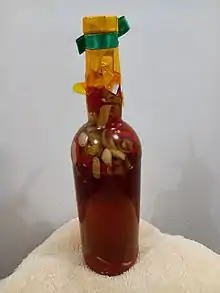Spiced vinegar
Spiced vinegar is a type of Philippine vinegar condiment that is made of vinegar e.g. fermented coconut sap (Cebuano: sukang tuba)[1] infused with spices primarily bird's eye chili and garlic.
 | |
| Alternative names | Sukang maanghang |
|---|---|
| Type | Condiment |
| Place of origin | Philippines |
| Associated cuisine | Philippines |
| Main ingredients | Coconut vinegar, chili pepper |
| Ingredients generally used | Garlic, ginger and/or galangal |
| Variations | Sukang Pinakurat, Sinamak, Sukang Quezon |
A variation of spiced vinegar was popularized by Rene Jose B. Stuart del Rosario of Iligan City in 2000 where the spices are finely chopped possibly with the use of a blender or food processor. This is now a mass-produced product under the brand name Sukang Pinakurat (derived from the Cebuano word kurat, meaning to "surprise" or "frighten").[2] Due to its popularity, the Stuart del Rosario family in 2004 had registered trademarks for sukang pinakurat, sukang waykurat, and sukang kuratsoy with the Intellectual Property Office of the Philippines.[3]
Flavor and uses

In Filipino households, this condiment is used on many assorted dishes, mostly fried dishes (includes lumpiang prito) and lechon.[4]
References
- "A Guide to Filipino Vinegars". Yummy.ph. May 18, 2017. Retrieved November 25, 2021.
- Carrasco, Ronnie (January 26, 2021). "Vina Morales joins food business". Manila Times. Retrieved November 25, 2021.
Others may know it as Sukang Pinakurat [a derivative of the Cebuano word "kurat" which means "surprise" or "frighten"]. But a lawyer-friend said some people might just create an issue out of it.
- Reyes, Jeymi D. (July 31, 2020). "War of the vinegars". Philippine Daily Inquirer. Retrieved November 25, 2021.
- Perez, Ace June Rell S. (October 21, 2018). "A feast in a box". SunStar Davao. Retrieved November 25, 2021.
